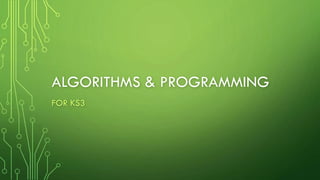
Algorithms and Programming
- 1. ALGORITHMS & PROGRAMMING FOR KS3
- 2. LEARNING OBJECTIVES ALGORITHMS • What is an algorithm? • Designing an algorithm • Why use flowcharts or pseudocode? PROGRAMMING BASICS • Program Structure • Sequencing • Selection • Iteration • Variables
- 4. WHAT IS AN ALGORITHM? • An algorithm is a set of step-by-step instructions to complete a task or solve a problem. • Algorithms are NOT computer programs! They help us plan and design the computer program code that will do the task. • Flow charts or pseudocode are useful for developing and visualising algorithms.
- 5. REAL-WORLD ALGORITHMS TASK ALGORITHM EXAMPLE Building flat-pack furniture Affix part A to part B using the supplied Allan key. Making a dress Cut along the grain of the fabric. Use of Television Press ‘Guide’ to access program listings. Assembly Instructions Sewing Pattern TV Operating Manual
- 6. SIMPLE ALGORITHM GETTING WASHED & DRESSED STEP 1 – GET UP 1. Get out of bed. 2. Eat breakfast. STEP 2 – WASH 1. Go to bathroom. 2. Wash face. STEP 3 - GET DRESSED 1. Remove pyjamas. 2. Put clothes on. 1. What are the INPUTS required to achieve the OUTPUTS required? 2. What STEPS are needed and in which SEQUENCE? 3. Are any DECISIONS needed? 4. Is there any REPETITION in the process? DO: Write an algorithm for brushing your teeth!
- 7. DESIGNING ALGORITHMS • Computers need exact instructions on how and when to perform a task. • We create a program that performs exact instructions in the algorithm. • An algorithm written using a flowchart or pseudocode can help us to write effective computer programming code. • They help to structure and SEQUENCE (order) the instructions. FLOWCHART & PSEUDOCODE EXAMPLE
- 8. WHAT IS PROGRAMMING? A Program is CODE written in a LANGUAGE that computers understand. • SEQUENCE is important so that a computer does the task in the right order. • SELECTION is the decision to make or question to answer. E.g. IF, THEN, ELSE. The path through a program changes depending on the answers. • ITERATION is looping through (repeating) a path until we reach our goal using FOR and WHILE statements. Iterative programming reduces the steps required by a program. Code contains STATEMENTS (single instructions) that tell the computer what to do.
- 9. EXAMPLE Declaring variables to store our information for use later on. DO: Identify the variables for the ‘brushing your teeth.’ Using iteration to loop through the steps whilst the ‘awake’ condition remains true. Using conditional selection to determine the path the program will take.
- 10. REFLECTION (PLENARY) WHAT DID YOU LEARN? What are your key takeaways from the lesson today? CONFIDENCE LEVEL? 1. Understood ALL of it, very confident. 2. Understood MOST of it, fairly confident. 3. Understood SOME of it and need some support. FURTHER LEARNING… NEXT LESSON: Datatypes, Variables, Constants and Operators.
Editor's Notes
- Step-by-step: Like giving directions to a friend. How do we write an algorithm? For a comic, we might draw pictures in a story board. We use flow charts and pseudocode to visualise our algorithm easily. Pseudo means ‘not the real thing’ so pseudocode is the instructions in our own words. Let’s be clear: Algorithms are NOT computer programs!
- When we design an algorithm, it forces us to think about the overall goal; the individual steps needed to accomplish that task. We consider the inputs required to achieve the output needed. The algorithm design process can also help us to think about different ways of solving problems. END OF SLIDE: Now write your own simple algorithm for brushing their teeth.
- Computers need exact Instructions! Take away the “Is water boiled” question – our while loop (ITERATION) – we could end up with a cold cup of tea! Take away the “put teabag in cup” statement and you have just hot water. Equally, the order (SEQUENCE) is important… is it milk first or last? One to discuss outside of the lesson!
- THIS IS WHERE PROGRAMMING COMES IN! SELECTION is important to manage the various paths through a program depending on decision points. Without selection, there would only be 1 path and the program would be ineffective and unrealistic. ITERATION is efficient and requires less processing as it managed the repetitive tasks. It keeps the algorithm simple.
- We learned about algorithms, what can helps us to design them, Program structure and basic programming concepts. At the beginning of the next lesson (before moving on), I would ask the students what they can recall from the last lesson. Perhaps ask different students to come out “Be the teacher” and give 1 minute mini teach on the different areas.